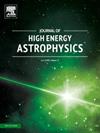来自 LHAASO 的极端 PeV 宇宙射线加速证据
IF 10.2
4区 物理与天体物理
Q1 ASTRONOMY & ASTROPHYSICS
引用次数: 0
摘要
众所周知,宇宙射线(CRs)作为带电的高能粒子,需要在各种天体物理环境中被磁场诱导的电场加速。由于天体物理等离子体的高导电性,大尺度电场只能存在于一些特殊情况下,如垂直冲击、喷流和旋转错位磁偶极子。由于还没有对这种大尺度电场的特性进行广泛探索,因此有关 CR 加速的观测证据还很模糊。大型高空气流淋浴天文台(LHAASO)的首批观测结果表明,尽管PeV粒子可能在各种超高能(UHE)γ射线源中被加速,但它们很可能从加速点逃逸,从而有效地产生了比来自银河系平面的漫射γ射线更柔和的UHEγ射线光谱。PeV粒子的全粒子能谱和对数质量平均值也表明,在光谱膝点附近有一个新的硬CR光谱成分,这可能与CR从其加速点逃逸并产生漫射γ射线辐射有关。高能粒子沿大尺度电场的漂移可能是PeV CRs加速的原因,从而解释了这些LHAASO结果。本文章由计算机程序翻译,如有差异,请以英文原文为准。
Evidence for extreme PeV cosmic ray acceleration from LHAASO
It is well-known that cosmic rays (CRs) as charged high-energy particles need to be accelerated by electric fields induced by magnetic fields in varieties of astrophysical environments. Due to the highly conductive nature of astrophysical plasmas, large scale electric fields can only exist in some peculiar circumstances, such as perpendicular shocks, jets, and spinning misaligned magnetic dipoles. Observational evidence for CR acceleration by such large scale electric fields is obscure since its characteristics haven't been explored extensively. The first results from the Large High Altitude Air Shower Observatory (LHAASO) imply that although PeV particles may be accelerated in varieties of ultra-high-energy (UHE) γ-ray sources, they likely escape from their sites of acceleration effectively giving rise to UHE γ-ray spectra softer than that of the diffuse γ-rays from the galactic plane. The all-particle energy spectrum and mean of the logarithmic mass of PeV CRs also suggest a new hard CR spectral component near the spectral knee that can be associated with CRs escaping from their site of acceleration and producing the diffuse γ-ray emission. The drift of high-energy particles along large scale electric fields may account for the acceleration of PeV CRs explaining these LHAASO results.
求助全文
通过发布文献求助,成功后即可免费获取论文全文。
去求助
来源期刊

Journal of High Energy Astrophysics
Earth and Planetary Sciences-Space and Planetary Science
CiteScore
9.70
自引率
5.30%
发文量
38
审稿时长
65 days
期刊介绍:
The journal welcomes manuscripts on theoretical models, simulations, and observations of highly energetic astrophysical objects both in our Galaxy and beyond. Among those, black holes at all scales, neutron stars, pulsars and their nebula, binaries, novae and supernovae, their remnants, active galaxies, and clusters are just a few examples. The journal will consider research across the whole electromagnetic spectrum, as well as research using various messengers, such as gravitational waves or neutrinos. Effects of high-energy phenomena on cosmology and star-formation, results from dedicated surveys expanding the knowledge of extreme environments, and astrophysical implications of dark matter are also welcomed topics.
 求助内容:
求助内容: 应助结果提醒方式:
应助结果提醒方式:


